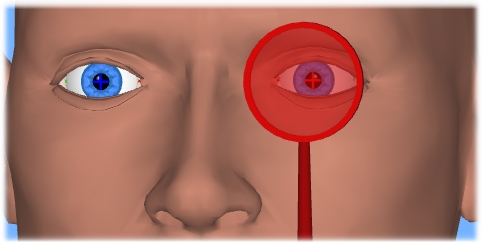Cover Test



Cover Test |



|
The cover test is used for the objective determination of type and extent of eye motility disorders by letting the patient fixate a nearby and a far away point while the eyes are intermittently or alternately covered with a blurred glass cover (or the hand) and by observing the fixation movements of the uncovered eye. With the cover test, horizontal and vertical deviations can be detected and measured. However, it is not applicable for measuring torsional deviations. Torsional movements can only be estimated by observing the rotation of globe vessels.

Covering the Left Eye with an Opaque Cover [Yanoff and Duker, 2003]
The first step when carrying out the cover test is to cover one eye and to observe and evaluate the movement of the uncovered eye. If a movement of the uncovered eye occurs in order to pick up fixation during the covering of the other eye, it has not participated in the fixation before, which means that in most cases it was squinting. With this examination method a manifest strabismus can be diagnosed. During the examination of both eyes, care should be taken to always uncover both eyes for a short period of time in order to allow fusion. Then the cover test can be carried out on the second eye. This is the so-called unilateral cover test.

Simulation of the Cover Test with SEE++
If no movement to pick up fixation can be observed during the unilateral cover test (central fixation is a prerequisite), the alternating cover test follows, where the cover is moved from one eye to the other eye (without an intermediate break). If now movements to pick up fixation can be observed, then a phorie (latent strabismus) exists. The diagnosis of a phorie is confirmed by the uncover test, where a previously covered eye is uncovered again. The movement of the uncovered eye is observed and if it performs a movement, a latent strabismus exists. Latent strabismus cannot be detected without covering.
SEE++ can simulate both the unilateral and the alternating cover test with the help of the biomechanical model. In addition, the simulation of manifest and latent strabismus is also possible, but the user has to specify the type of strabismus before the system can simulate it. Moreover, the preferred fixing eye can be chosen, which determines the eye that is set as the fixing eye by the SEE++ system after the cover has been removed from the covered eye or when no eye is covered.